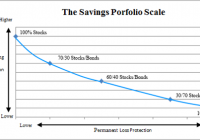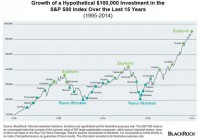The surprising plummet in petroleum prices over the past 12 months has caught a lot of people off-guard, and has presented a variety of consequence. For investors, It has created downward pressure on most, but not all petroleum-related equities. For many Americans with less of a vested interest in the matter, the drop has meant a quasi-tax-cut, with a gallon of gas falling from $4-$5 a gallon to something a bit more tolerable. Those employed by the industry may be fearing for their position or may have already been told they are out of work. Foreign economies dependent on oil exporting are vulnerable to economic collapse. The integrated oil giants such as Chevron (NYSE: CVX ), Exxon (NYSE: XOM ), and BP (NYSE: BP ) tend to be core holdings in many long-term portfolios. While perpetual optimists – sometimes referred to as “perma-bulls,” seem steadfast in the view that oil prices will “come back,” I would caution against that assumption. “Forever” investors – those that buy and generally never sell a stock – have no choice but to think in optimistic terms since they, either voluntarily or involuntarily, lock themselves into ownership. The fact of the matter is we don’t know that oil will “come back.” We may never see $100 a barrel oil again in our lifetimes. Near-term we are swimming in a veritable glut of the stuff. Supply imbalance combined with bullish speculator abandonment of petroleum, has created, as is typically in today’s fluid financial markets, a frenzy of attention. OPEC has not helped those looking for a price reprieve and seems keen on keeping production level, and prices low. The price of the United States Oil Fund LP ETF (NYSEARCA: USO ) has fallen 28 percent in six months. Whether you think the price action is justified or not should not be a huge consideration, although a forward thesis can help you keep focus on how your approach energy investment. As an investor you must learn to cope with varying situations. To assume you know what the price of oil will do in the coming months, years, or decades, is foolhardy. Uncertainty of financial markets is why diversification, amongst asset type, sectors, stocks, and investment style is such a strong risk management tool. For some investors, adding to these kinds of stocks may make sense here, for others, taking their lumps and decreasing net exposure to oil may be the proper move. Opportunistic investors should avoid obsession over the decline in oil stocks , instead focusing in on industries that might benefit from prolonged cheap oil. Instead of adding to a position in Exxon, which is being pressured, how about investing in airlines – an industry where fuel is a significant expense. How about cruise lines – again, an industry that sees fuel as a significant input and where tame pricing leads direct to the bottom line. Automakers stand to benefit the longer oil prices stay low . With more disposable income in their pocket, consumers may opt for bigger gas guzzlers that means higher margins for auto companies. How about trucking companies? Get out of the box and start thinking where profits may be soaring. While Exxon has dropped 25% the past year, Southwest Airlines (NYSE: LUV ) has risen 25 percent. That disparity could continue. Don’t short USO, when there’s safer plays that could be just as rewarding out there against an oil collapse. There are certainly other areas in the market where waiting around for something to happen has not been the wisest of bets. For years there have been those thinking that the bond market has been in a bubble. Most of these investors have sat on the sidelines, most likely in cash, waiting for a massive rise in interest rates that has yet to materialize. It may never materialize . As I write this, the 10-Year Treasury sits at 2.15% after briefly brushing up against 2.5 percent. While even I have cautioned against getting too slap happy with long-term bonds – those with bond exposure have earned their coupons without issue, while those who’ve sat in cash have suffered tremendous opportunity cost. Even if the Fed moves to tighten this year, which is starting to seem rather likely, it’s possible that long rates continue their dovish pattern. Who benefits from low rates? Highly levered companies with solid business models that can obtain low cost capital. Again, instead of focusing on when rates will rise, take advantage of what is, and has been, on the table for quite some time now. Might that end tomorrow,? Perhaps. But don’t invest like you absolutely know how things will shake out. Hedge yourself and manage risk. Indeed, leveraging an entire portfolio to one idea can pose disastrous risk. The investor less exposed to energy over the past year or leveraged to ideas premised on falling oil prices (airlines, cruise lines) has made out like a bandit. Your great-grandfather who has pledged absolutely allegiance to oil stocks, not so much. Instead of guessing when things might happen or sitting on an industry or idea that has obvious headwinds, learn to embrace what the economy and financial markets afford you. It’s one thing to be optimistic. It’s another thing to pretend you know more than you really do. Disclaimer: The above should not be considered or construed as individualized or specific investment advice. Do your own research and consult a professional, if necessary, before making investment decisions. Adam Aloisi was long shares of Southwest Airlines, Norwegian Cruise Line, Exxon, and General Motors at time of writing, but positions can change at any time. Link to the original post here

